The Maidan was a turning point for the Ukrainian civil society. Since the Revolution of Dignity local and national initiatives of citizens gained an explosive growth. Liudmyla Tiahnyriadno, journalist at the public radio Suspilne, collected six stories of civil society initiatives that emerged or transformed in times of war and will be drivers of change, not only during wartime but also in post-war Ukraine.
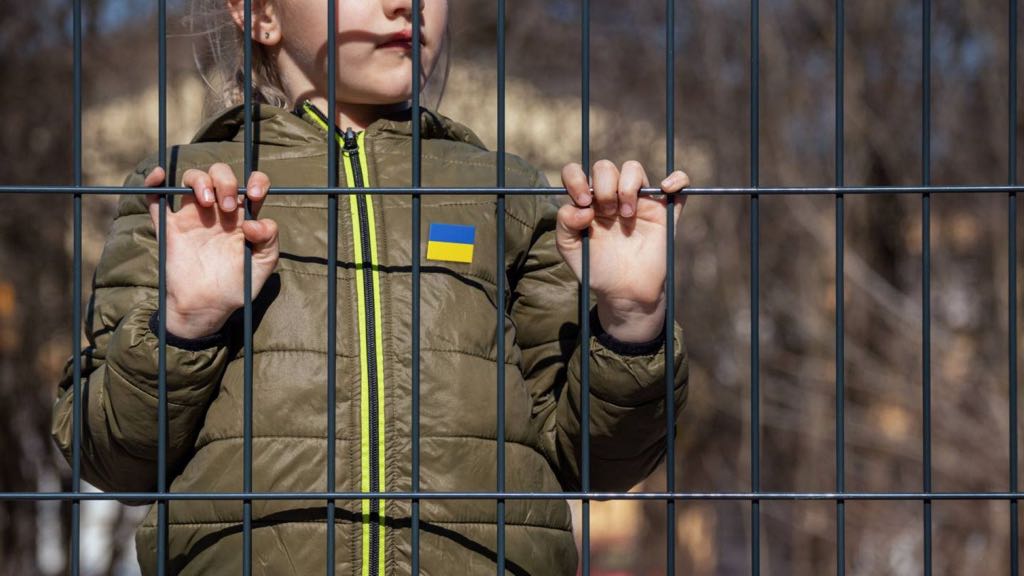
Abducted child. Picture S&D
By Liudmyla Tiahnyriadno
Ukrainian civil society with thousands of local and national initiatives gained an explosive growth 9 years ago as a result of the Revolution of Dignity of 2013/2014. Civil organizations became the drivers of change in the state and society. Many public figures joined the civil service striving to transform the system from within. Examples of successful cooperation between non-governmental organizations and authorities soon sprung up.
When Russia annexed Crimea and unleashed a war in the east, a powerful volunteer movement bolstered the tendency. Finding resources and solving problems that the state could not solve is a superpower of Ukrainian society. When Russia launched a full-scale offensive on 24 February 2022, this superpower was one of the main reasons why the Ukrainians managed to hold out.
During the year and a half of the full-scale war, 3500 of new non-governmental organizations and foundations were registered in Ukraine. In total, there are almost one hundred thousand of them in Ukraine; yet many initiatives have no official registration. Currently, Ukrainian civil society organizations are engaged in literally everything, from providing supplies for the military to rescuing animals from war, from helping internally displaced people to advocating sanctions against Russia, from organizing leisure activities to developing environmental restoration plans.
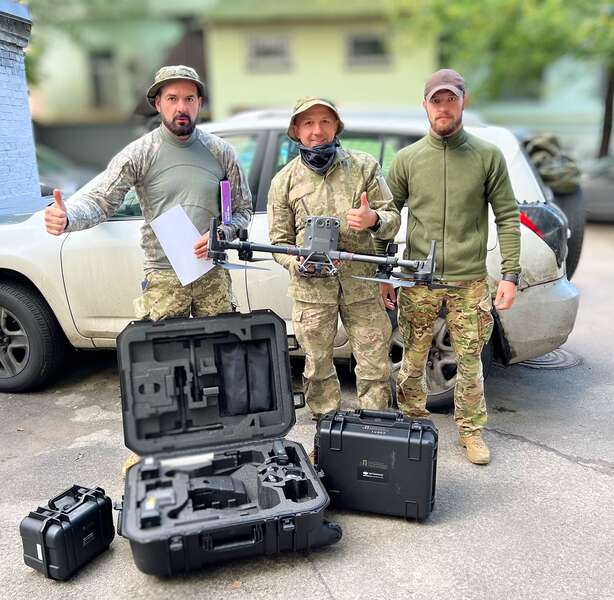 Drones for the army are provided through crowd funding. Photo Prytula foundation
Drones for the army are provided through crowd funding. Photo Prytula foundation
Part of these efforts is financed by international donors, but the same time, Ukrainians have developed a strong donation culture: millions of people regularly transfer money to volunteers and public organizations. Big organizations like Serhiy Prytula Charity Foundation or Come Back Alive Foundation fundraise millions of dollars for helping Ukrainian army. Moreover, volunteering and civic activism became a solution for those who want to help the country, but do not join the army.
People who evacuate others from the occupied territories
‘When my city was occupied, I could not just stay by’, Albina Shevchenko says. She is from Mariupol, although she lives in Kyiv. – I started looking for a driver, buses, fuel. On March 16, we had the first evacuation ride. There were 18 seats in the minibus, and we took 30 people to Zaporizhzhia’. Albina works for the HelpPeople NGO, which evacuates civilians, including those seriously ill or persons with severely limited mobility, from the occupied and frontline territories.
Albina joined the HelpPeople team after that first ride, and soon several buses started evacuating people. Now HelpPeople aids residents of the occupied part of the Kherson region. In total, about twenty-five thousand people were taken out of the occupation.
Volunteer bus drivers risk their lives. During the evacuation from Mariupol, the Russians captured ten HelpPeople drivers. They were kept in basements, tortured, and denied water. ‘After being released from captivity, two drivers resumed working. They don't go to the occupied territories because they are not allowed to go there, but they work in the front-line areas’, Albina says.
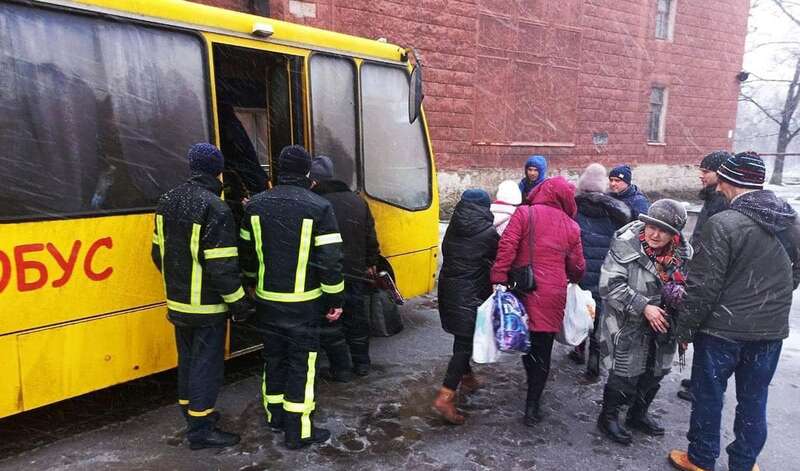 Civilians are evacuated from Volnovakha in the Donetsk region. Photo Wikipedia CC.
Civilians are evacuated from Volnovakha in the Donetsk region. Photo Wikipedia CC.
The Russians often deliberately fired artillery at evacuation points. While leaving Lysychansk in Luhansk region, the HelpPeople team got under fire; one of the drivers lost an eye.
HelpPeople has special minibuses with couches and carts to transport people with disabilities. And the organization helps people to leave even the occupied territories, which cannot be accessed through the frontline: it pays for fuel, gives money for departure, assists in the preparation of documents.
Another challenge for volunteers is to gather people and convince them to evacuate. Often, residents of occupied and front-line territories refuse to leave because ‘they don't know where they are going’, says Albina. More than once people agreed to evacuate only when a projectile hit their house. ‘We deliver humanitarian kits to those who refuse to leave. We feed them because they have nothing – neither water nor food’, says the volunteer.
People who save children abducted by Russia
Ukraine inherited a system of prison-like state orphanages from the Soviet Union. Before the full-scale invasion, the non-governmental organization SOS Children's Villages Ukraine engaged in a comprehensive solution to this problem: from advocating for reforms to helping families and providing comfortable conditions in foster families for children deprived of parental care, as well as preparing orphans for independent life. In 2022, activists set out to save deported Ukrainian children.
No one knows how many children the invaders abducted from Ukraine to Russia or displaced within the occupied territories. According to the official statistics, as of 26 June, 616 children are considered missing, 19,499 — deported. The actual number may be much higher.
‘We received information that children who had been staying in resorts or recreation centers during the occupation of Mariupol were taken to occupied Donetsk, and then to Russia. Later, the same thing happened in the occupied territories of Kharkiv, Kherson and Zaporizhzhia regions’, says Dariya Kasyanova, National Development Director of SOS Children's Villages Ukraine programs. ‘Sometimes parents agreed to send their children to a camp for recreation, expecting them to return in a few weeks, but months pass, and the children are not there.’
Children are often transported to remote Russian regions, where they are accommodated in places not suitable for living. The children who were saved tell about bullying and psychological pressure. ‘The Russians are trying to deprive the children of their identity’, says Darya. In some places, Ukrainian children, even those who have relatives in Ukraine, are forcibly placed in foster families.
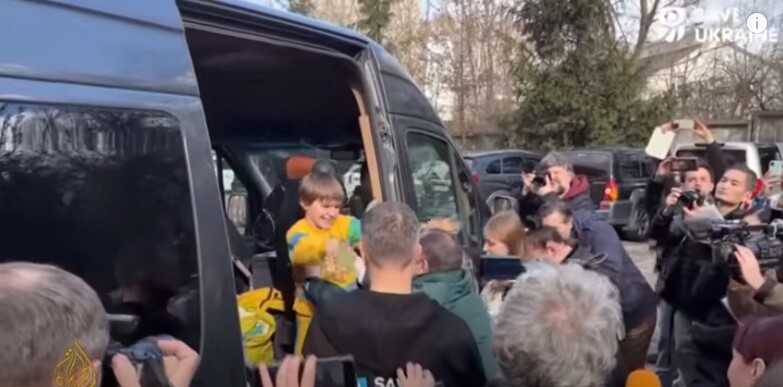 Deported children are welcomed by family at their return in Ukraine. Screenshot from Youtube.
Deported children are welcomed by family at their return in Ukraine. Screenshot from Youtube.
SOS Children's Villages Ukraine together with the Ministry of Reintegration work on the return of deported children: they help to draw up documents, plan logistics, provide psychological support to those who plan to go to Russia to get a child out. Specific methods of returning children to the organization are not disclosed, for it being dangerous. ‘The most difficult cases are when parents have died,’ says Dariya Kasyanova. ‘It is not enough to find relatives; it is necessary to understand at least approximately where and when the child could have been taken.’ ‘SOS Children's Villages Ukraine’ helps children who have been returned – and there are dozens of them – to adapt at their homeland.
People who help rebuild the destroyed houses
Bucha, Irpin, Hostomel, Borodyanka – the names of these towns near Kyiv are now known to the whole world. Fierce battles raged here with the invaders who tried to break through to Kyiv. Many houses were destroyed by shelling. The Brave to Restore initiative took roots during the repairing of one of them.
Every weekend, teams of 10-15 volunteers of the initiative go to towns and villages where people need help rebuilding their homes destroyed by the Russians. It all started in Kyiv region, and later volunteer teams consolidated in Kharkiv and Kherson regions. Debris get dismantled, windows and roofs are repaired so that people can continue living in their houses. There is a lot of work: the Russians have already destroyed about 150,000 houses and left a million Ukrainians homeless.
‘We do not only help people, for example, with bricks or roof repairs, we also communicate with these people. Our volunteers give them hope that they are not left behind, that they will get help, that everything will be fine’, says Vitaliy Selyk, co-founder of the initiative. Volunteers also deliver humanitarian aid and distribute bicycles to people who have lost their own transport.
Brave to Restore initiative procures construction materials through micro-grants, and donations are also collected. ‘The reconstruction of individual houses is only part of the work we are planning. In the future, I would like to replan and rebuild cities and villages. War is, on the one hand, a bitter grief, suffering and crisis, on the other hand, it is a point of reset that provides great opportunities’, says Vitaliy Selyk. He is among those who expect that the restoration of Ukraine will give a chance not only to build new houses instead of destroyed ones, but also to remedy the mistakes of the first decades of independence and get rid of social flaws inherited from Soviet times.
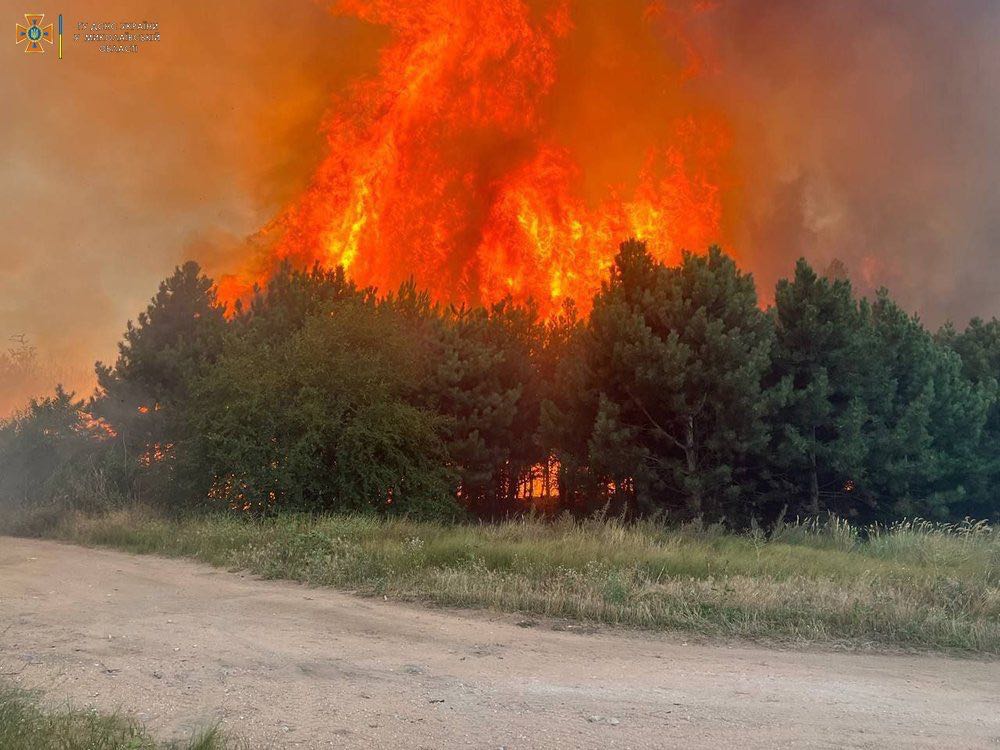
Forest fire in Mykolaiv after Russian shelling. Picture Wikicommons.
People who make rebuilding environmentally friendly
Activists of the Ecoaction organization also hope to implement their visions in the process of recovery. They advocate for energy efficiency and renewable energy, the development of sustainable transport and agriculture, oppose industrial pollution, etcetera. Recovery is a chance to switch to energy-efficient and clean technologies. ‘We are trying to consolidate public organizations and work to ensure that the recovery process adheres to new principles. So that people are willing to return to the new country’, says Nataliya Gozak, Executive Director of Ecoaction.
It is important for eco-activists that all environmental protection and energy efficiency considerations are taken into account at the stage of reconstruction planning. ‘The city decides either to rebuild the road with a lane for public transport and bicycles, with a green zone, or to use the same money to widen the road and compensate motorists. This will determine whether we will have cities for cars, or whether we will have cities for people’, Natalia explains.
Rebuilding everything that was destroyed by the Russians in the same form and format as before the full-scale war will deprive the country of a chance for renewal. Therefore, eco-activists insist that money for restoration projects be allocated only on the condition that the projects are ‘green’: ‘Funding must go hand in hand with the fulfillment of requirements that must be linked to the progress of Ukraine's membership in the European Union. We will convince the authorities that we need to include a ‘green’ component in the recovery’.
In addition to ‘green’ recovery, Ecoaction has embarked on the new activity areas: advocating for the introduction of sanctions against Russia, which will prevent it from exporting fuels, and documenting the environmental crimes committed by the occupiers for the future litigation.
People promoting sanctions against Russia
The Center of Combating Corruption, one of the most powerful anti-corruption watchdogs in Ukraine, is also engaged in the advocacy for sanctions. This organization contributed to the introduction of sanctions against pro-Russian politicians, the family and cronies of the former President Yanukovych, monitored the ties of Ukrainian politicians with the Kremlin, and also contributed to the creation of transparent anti-corruption bodies. Now the Center for Combating Corruption has taken up new activity areas.
‘When Ukraine refused to surrender, and Zelenskyi said that he ‘needs ammo, not a ride ‘, when he was offered to leave Kyiv, it became a powerful call to mobilize all forces inside the country – the army, public resistance forces, and volunteers, — to protect our state’, says the Executive Director of the organization, Daryna Kaleniuk. Thanks to their global network, activists of the Center for Combating Corruption began to promote the idea of introducing new sanctions against Russia, to identify and expose the assets of Russia and Russian politicians abroad, to encourage the West to introduce an all-out embargo on Russian fuels and to give Ukraine the weapons necessary to protect and restore its integrity. The Center for Combating Corruption calls on the governments of the countries that have not yet been engaged in providing the aid not to be ‘neutral’ but to make a choice in favor of the civilized world.
‘We demanded to support the Ukrainian victory, because this is the only way ahead to peace. Therefore, Western governments later began to communicate the message that Ukraine will win and are ready to provide weapons to help in this’, Daryna Kaleniuk says. Activists organize advocacy visits, meetings with politicians and the media, inviting, in particular, the women serving in the Armed Forces of Ukraine, so that the West has a firsthand account of the war in Ukraine.
People who sew clothes for women serving in the army
The Women Veterans Movement also helps women serving in the army. This organization, which protects the rights of women who had been and are fighting, was founded in 2019. With the beginning of the full-scale war, some of the founders returned to the frontlines, and the others scaled-up assistance to women in the military. In particular, they set up a workshop sewing military uniforms.
‘Men's and women's knees are at a different height’, says Yuliya Kirillova, coordinator of the social sector of the ‘Women Veterans Movement’. ‘Therefore, when we buy a uniform with knee pads, it fits men properly, but for women, these knee pads are higher than necessary. Therefore, we developed a cut of the female uniform that fits all anatomical features.’ In addition to uniforms, the Women Veterans Movement has designed women's army underwear and provides it to women in combat: the army has not yet ordered these items. They plan to sew T-shirts, hats, balaclavas and thermal underwear.
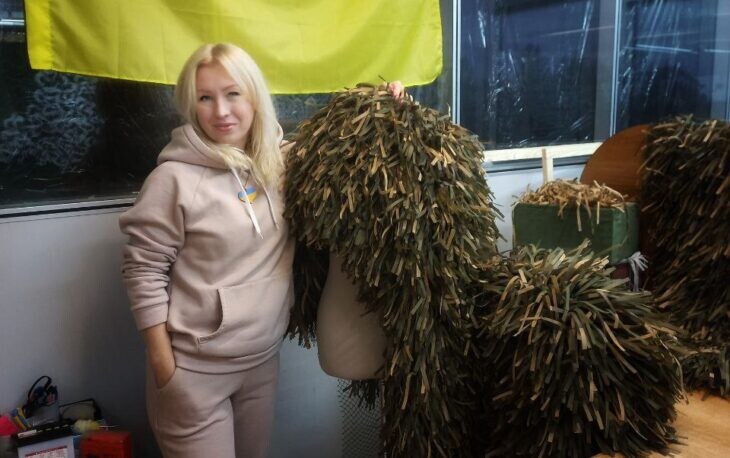 A volunteer makes camouflage nets for the army. Photo from Women Veterans Movement
A volunteer makes camouflage nets for the army. Photo from Women Veterans Movement
When the full-scale invasion started, the Women Veterans Movement turned into a volunteer hub. ‘We prepared meals, delivered food to the basements, fed people. The headquarters helped female veterans who became servicemen again. We bought cars, tactical medical items, delivered aid to civilian hospitals’, Yuliya Kirillova says. Currently, the humanitarian headquarters on the basis of the organization helps displaced people, people from the combat zone, has evacuation crews that take people and animals out of the danger zone.
Volunteers and visitors to the headquarters of the Women Veterans Movement weave camouflage nets for the military. Today, people who weave such nets work in almost all Ukrainian cities and towns. Volunteers are invited to weave nets in volunteer offices, libraries, museums, cultural centers, schools and universities. It takes days to attach hundreds of fabric scraps onto a rope net. This painstaking, monotonous work, which everyone can manage – children, people with disabilities, the elderly and those whose relatives are at the frontlines – relieves anxiety and gives a sense of belonging to a common cause. Nine years ago, the Revolution of Dignity revealed to many people in Ukraine that the contribution of each of them to democracy and the struggle for change for the better is important. And now, during the full-scale war for independence, this idea consolidated the society.
Drivers of change, also in post-war Ukraine
So far, public organizations and volunteer initiatives remain the drivers of change in the state, as well as co-creators of the country's recovery. They develop ideas and concepts of the intangible component of recovery — from ways of organizing urban space to reforms in the fields of health care or education. Thirty civil society organizations united into the RISE coalition aiming at ensuring transparency and accountability of the post-war reconstruction and spending international aid funds. Other initiatives develop opportunities for rehabilitation and socialization of veterans and civilians affected by war.
Actually, these grass-root initiatives demonstrate better vision and long-term strategy than a clumsy state machine, as well as more maturity and devotion than many politicians. Civil society in Ukraine has grown into a potent power and game-changer, it is able to advocate for necessary reforms, serve as a watchdog and protect those who needs protection. Moreover, coming through this war which literally became a question of survival for Ukrainian society will strengthen non-governmental sector even more. Thus, civil society organizations will become the basis post-war Ukraine will rebuild on.
About the author
Liudmyla Tiahnyriadno is a reporter/presenter for Ukrainian Public Radio. She has been working there since the beginning of the reforming of Ukraine’s National Radio Company into the public broadcaster Suspilne after the Maidan-revolution. Tiahnyriadno is currently living in Kyiv. She is also the producer of Window on Kherson, a documentary about the 256 days of Russian occupation of Kherson.
This article is a coproduction of Liudmyla Tiahnyriadno together with the Ukraine Voices Appeal of The Institute for War & Peace Reporting and Raam op Rusland.
